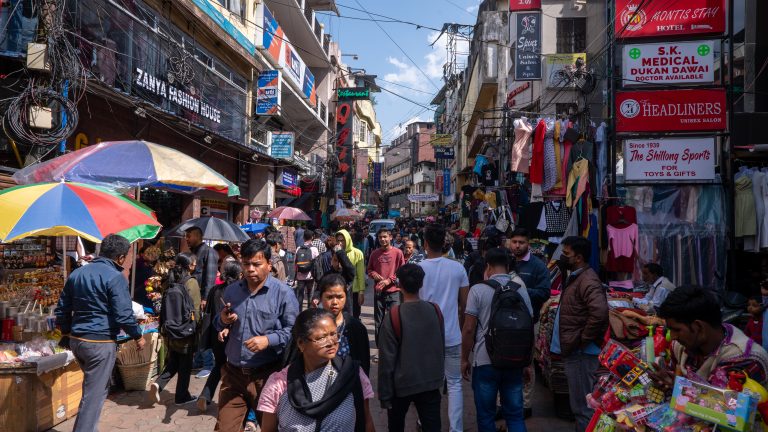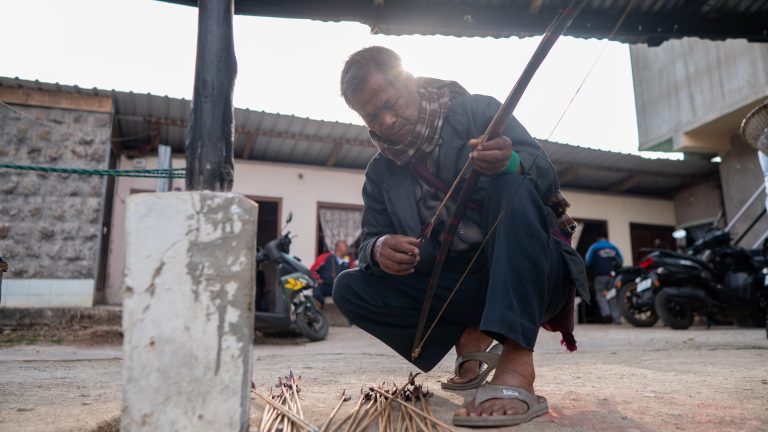Every day at 3 p.m., Bankur Goswami’s phone starts buzzing nonstop with payment alerts. These money transfers — that come through apps like Google Pay, Paytm, or WhatsApp — are for betting on teer, an archery game popular in India’s northeastern state of Meghalaya. Goswami is one of around 5,000 licensed teer bookies in Meghalaya, and has been in the business for over 25 years.
Though archery has been a tradition among the Khasi people of Meghalaya for centuries, teer betting started somewhere around the early 20th century. The sport involves a group of archers shooting teer — “arrows” in Hindi — at stacks of straw. It’s played every evening at the Polo Ground — not too far from Goswami’s betting counter. There are several ways to place bets, one of which is to pick a two-digit number — also the last two digits of the total number of arrows that must hit the stacks to win the bet. For example, if someone bet on the number 47, and the archer landed 247 arrows, they’d win the bet.
Until 2021, Goswami only took over-the-counter cash bets at his shop in Shillong, the capital of Meghalaya — his clients were limited to the state. Now, he accepts bets from teer fans in neighboring states like Assam, Tripura, Manipur, and even countries like Bangladesh and Bhutan.

Rajesh Kedia, who runs a teer counter in Shillong, recalls a time when the only way to know scores was to have someone stationed at the game. “Back in the 90s, every teer counter would have someone posted on the grounds to see the archery game live,” he told Rest of World. “Immediately after the game, they would call on the landline to tell the numbers.” Though cellphones eased this process, “now, most of us watch the livestreaming,” Kedia said.
This shift to online betting was triggered by Covid-19. During the 2020 lockdowns, teer counters were closed for months, reportedly resulting in losses of 40 crore rupees ($4.8 million) for Meghalaya. To offset the financial hit, the state’s government allowed non-contact sports to resume in 2021, and the teer regulatory body, Khasi Hills Archery Sports Institute, decided to begin livestreaming the game. Teer bets were no longer limited to in-person transactions — thanks to online streaming and digital payments, they could now be placed from anywhere.

The Khasi Hills Archery Sports Institute now has more than 163,000 subscribers on YouTube and over 30,000 average daily views for live broadcasts. Other channels, such as Archery Sports Institute (102,000 subscribers) and Khasi Hills Archery (over 39,000 subscribers), also stream the game, release scores, and provide betting tips, as do apps like Shillong Teer Counter and Online Teer.
According to Philip Gene Khongsngi, president of the Khasi Hills Archery Sports Institute, 75% of the viewership on the teer YouTube channels is from outside Meghalaya. “Now, because of the online bit, anyone can just call a bookie in Shillong, make a bet, pay online, and can participate in the game,” Khongsngi told Rest of World. There are 12 clubs affiliated with the institute, and the teer archers who play the sport are selected from these clubs.
While sports betting is mostly illegal in India, there are a few exceptions, including for teer, which is governed by a gambling law specific to Meghalaya. “The legalization of teer is an exception because of the cultural value that it holds in the state,” Jay Sayta, a tech and gaming industry lawyer based in Mumbai, told Rest of World. “Even horse racing is an exception. From time to time, certain games have been exempted from the laws banning gambling and betting in general.”
Teer betting provides employment to 10,000–15,000 people, and brings hundreds of millions in revenue to the state, Khongsngi said, adding that each teer shop earns a minimum of 2,000 rupees ($24) a day. Bookies told Rest of World online betting has doubled the earnings at teer counters.
Vishal Deb, 32, runs a teer-betting counter in one of the busiest areas in Shillong. Around 1,000 people walk in to place bets every day, he told Rest of World, whereas online, Deb books around 3,000–4,000 bets a day. His clients place bets through social media channels like Facebook and WhatsApp. While his earnings from offline bets are about 100,000 rupees ($1,219) a day, Deb said they can reach 200,000 rupees ($2,437) online.
“These online bookings are mostly from the borders of Bangladesh and Bhutan,” he said. Most payments come in via apps such as Google Pay and PhonePe, though some still pay through internet banking, he added.
Another bookie, who requested anonymity as he’s in the process of renewing his license, told Rest of World he makes 15,000–20,000 rupees ($182–$243) offline, and 10,000–12,000 rupees ($121–$146) online in a day. “Most of the online bets that I get are from different districts of Assam,” he said.
Many regular bettors believe their dreams guide them to certain numbers that can win them bets. “For instance, if you dream of a dog walking on a road, the number will be 74 or 47, where seven stands for the road and four stands for the four-legged dog,” Tikaram Sharma, a local who has been placing bets for years, told Rest of World.

While the game has only male archers, many women run counters and even gamble, but covertly, Sharma said. “It is considered as a taboo across many sections in the state, and many prefer to play in secret,” he said. Shimli Rawa, 29, has been placing bets for over a decade. While she often watches the game online, she places her bets at the counter as it’s right next to her home “I play almost every day in the first two weeks [of every month] … and win around twice [or] thrice in a week.”
Even though the game has found popularity online, running a teer-betting business on the internet comes with its challenges. Meghalaya has seen multiple internet shutdowns in the past couple of years. A single day of no internet could result in losses up to 50,000–100,000 rupees ($609–$1,218), said Deb.
Online, there’s also a higher risk of bettors getting duped. According to Kedia, many bookies create groups and channels on WhatsApp and Telegram to lure bettors with the promise of sharing popular numbers of the day hours before the game. “These are rigged and many have been duped of their money. People who do not know the nuances of the game usually fall for these tricks,” Kedia said.

India’s betting market, which mostly runs through illegal or underground channels, sees an annual business of around $100–130 billion, said Sayta, the gaming industry lawyer. Though legalizing this sector would “bring in more revenue, employment, be a boost for the digital and tech industry, and help curb black money,” Sayta believes there are some clear pitfalls that the government “cannot ignore,” such as financial losses, addiction, and health-related issues.
“Many believe that given our socioeconomic structure and per capita income, legalizing betting may not be desirable at this stage,” he said.
But teer bettors see the game as something that’s a lot bigger than gambling. Despite the challenges, teer “always revives,” said Sharma, the veteran bettor. “It’s more of a way to hold on to your culture than a game in the state.”







